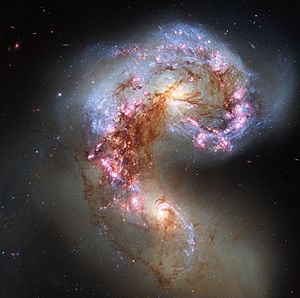Corvus (constellation) facts for kids
| Constellation | |

List of stars in Corvus
|
|
| Abbreviation | Crv |
|---|---|
| Genitive | Corvi |
| Pronunciation | genitive |
| Symbolism | the Crow/Raven |
| Right ascension | 12 |
| Declination | −20 |
| Quadrant | SQ3 |
| Area | 184 sq. deg. (70th) |
| Main stars | 4 |
| Bayer/Flamsteed stars |
10 |
| Stars with planets | 1 |
| Stars brighter than 3.00m | 3 |
| Stars within 10.00 pc (32.62 ly) | 1 |
| Brightest star | γ Crv (Gienah) (2.59m) |
| Messier objects | 0 |
| Meteor showers | Corvids (June 26) |
| Bordering constellations |
Virgo Crater Hydra |
| Visible at latitudes between +60° and −90°. Best visible at 21:00 (9 p.m.) during the month of May. |
|
Corvus is a small constellation you can see in the southern sky. Its name comes from Latin and means "raven" or "crow".
This constellation has only 11 stars that are bright enough to be seen without a telescope. Corvus is one of the 88 modern constellations we know today. An ancient astronomer named Ptolemy first listed it. He saw 7 of its stars.
Contents
Discovering Corvus's Stars
Corvus is known for its main stars that form a unique shape.
The Sail of Corvus
Four important stars in Corvus create a group that looks like a sail. These stars are named Delta, Gamma, Epsilon, and Beta. This group is sometimes called "the Sail."
A Star Mistaken for a Moon
There is a star named 31 Crateris. It has a brightness of 5.2 magnitude. Long ago, people thought this star might be a moon of Mercury. But it is actually just a star in space.
Exploring Deep Space Objects
Corvus does not have any Messier objects. These are famous deep-sky objects that astronomers often look for.
The Antennae Galaxies
One amazing object in Corvus is the Antennae galaxies. These are two galaxies, NGC 4038 and NGC 4039, that are crashing into each other! From Earth, they look a bit like a heart. They are called the Antennae Galaxies because long "tails" of stars and gas stretch out from them. These tails look like antennae.
NGC 4361: A Special Nebula
In the middle of Corvus, you can find a planetary nebula called NGC 4361. A planetary nebula is a cloud of gas and dust formed when a star dies. This nebula looks like a small elliptical galaxy, but it is not. The star at its center is very dim, which tells us it's not a huge galaxy.
The Myths of Corvus
The story of the Corvus constellation is connected to two other constellations: Crater (the Cup) and Hydra (the Water Snake).
The Raven's Black Feathers
Long ago, the crow was said to have beautiful silver or white feathers. It could also speak to humans. The god Apollo loved this special bird. When Apollo's girlfriend, Coronis, was going to have a baby, Apollo asked the raven to watch over her.
But Coronis fell in love with another human. The crow secretly watched her and told Apollo. Apollo became very angry. He changed the loyal raven's feathers from white to black. He also took away the bird's ability to speak. Apollo's twin sister, Artemis, then killed Coronis. However, Coronis and Apollo's child survived. This child grew up to be Asclepius, the god of medicine.
The Thirsty Raven's Punishment
In another story, Apollo sent his raven to get water using the god's cup, the Crater. But the raven saw some figs that were not ripe yet. He waited and ate them. This made him very late.
When the raven finally came back, he brought a water snake, a Hydra, and the cup of water. The foolish raven tried to blame the water snake for his delay. Apollo was not fooled. He placed the raven, the water snake, and the cup in the sky as constellations. In the sky, the snake keeps the thirsty raven from reaching the water in the cup. The raven can see the water, but it is always just out of reach.
Ancient Origins of Corvus
The idea of a raven constellation is very old. It is similar to the Babylonian raven (MUL.UGA.MUSHEN). The Babylonians also showed their raven sitting on the tail of a snake. This Babylonian constellation was important to their god Adad, who was the god of rain and storms. In ancient times, this constellation would appear in the sky just before the autumn rainy season began.
Images for kids
-
Corvus as shown on The Manuchihr Globe, made in Mashhad in 1632-33 AD.
See also
 In Spanish: Corvus (constelación) para niños
In Spanish: Corvus (constelación) para niños




